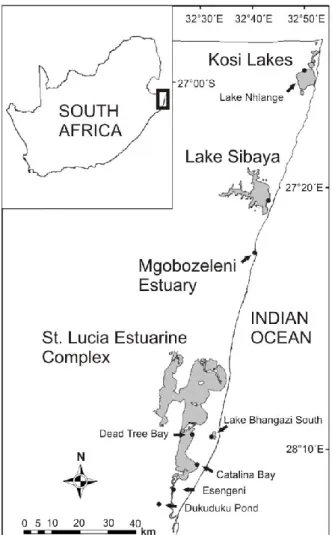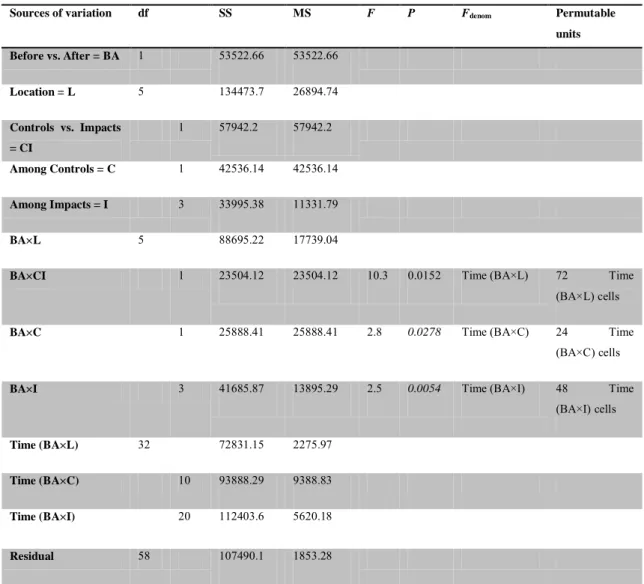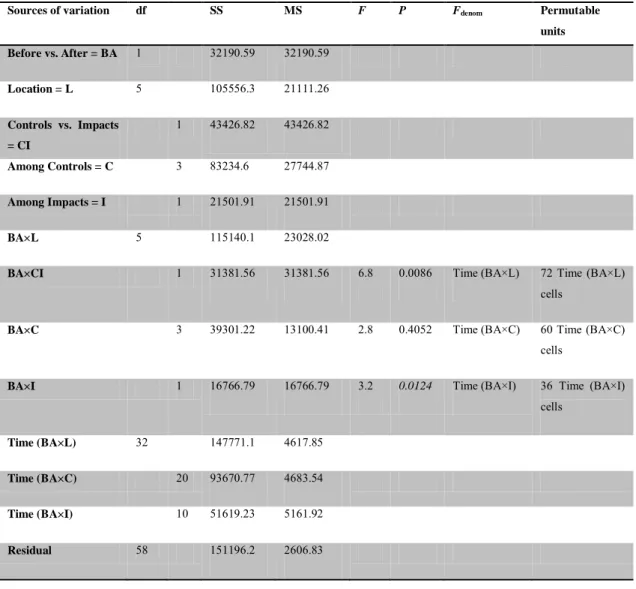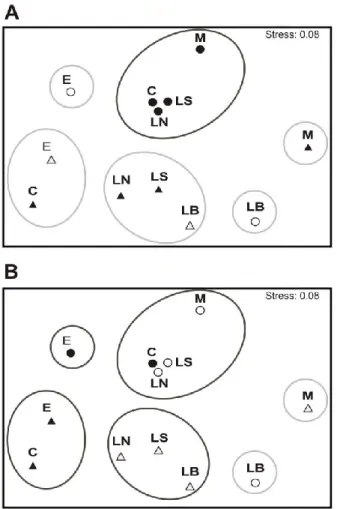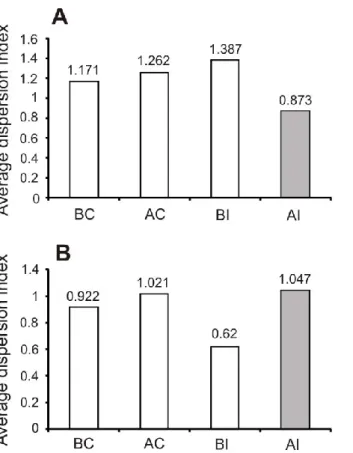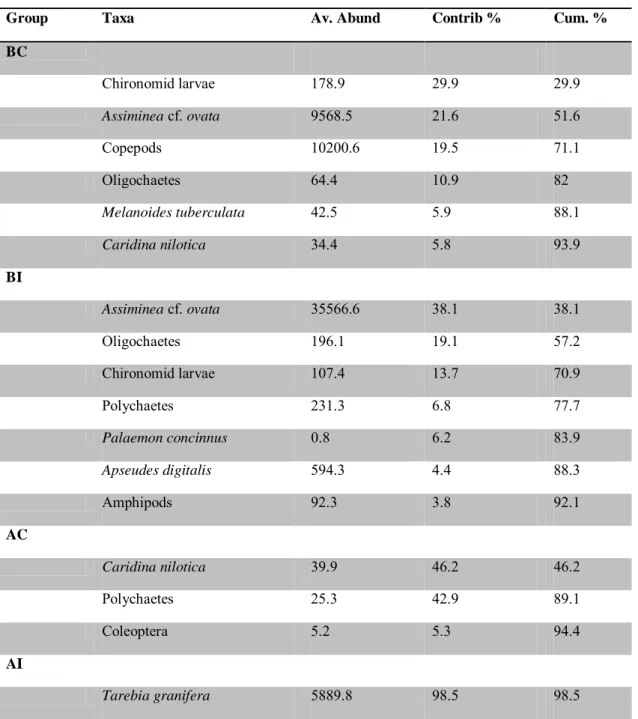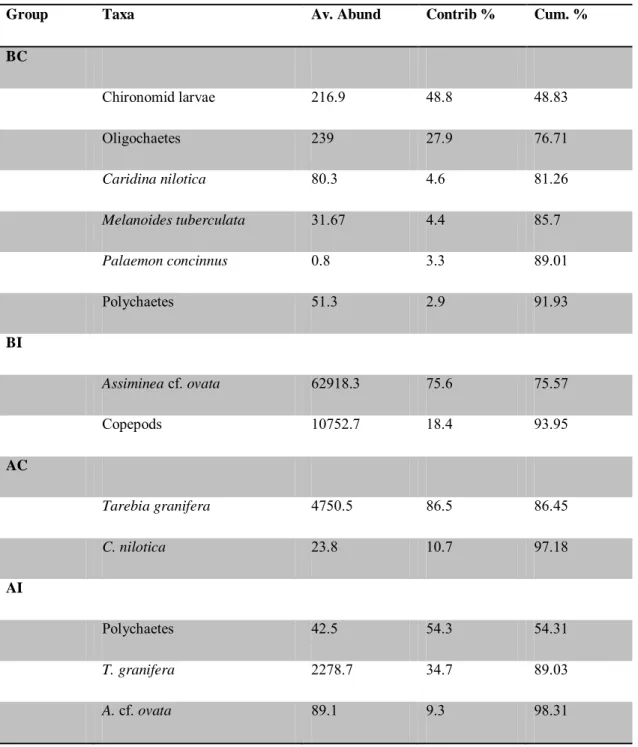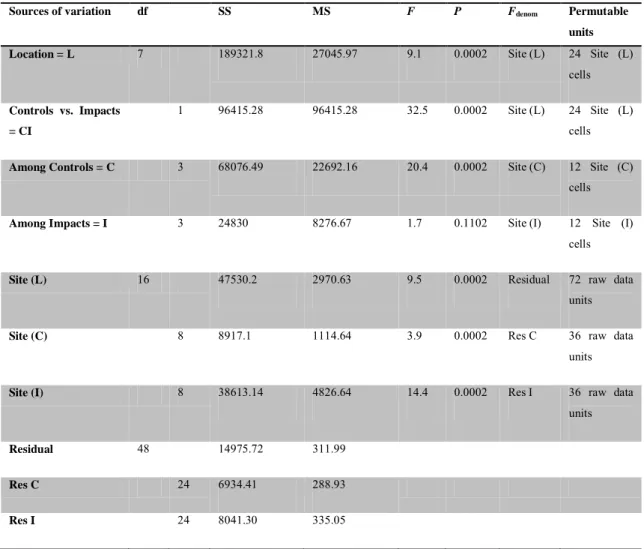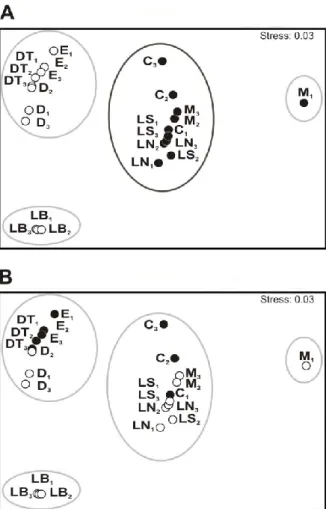Ecophysiology and population dynamics of the alien invasive gastropod Tarebia granifera in the
iSimangaliso Wetland Park, South Africa.
Nelson Augusto Fernandes Miranda
Submitted in fulfillment of the requirements for the degree of Doctor of Philosophy, in the
School of Life Sciences
University of KwaZulu-Natal, Westville
February 2012
As the candidate’s Supervisor, I have approved this thesis for submission.
Abstract
Tarebia granifera is a prosobranch freshwater gastropod from south-east Asia which has invaded other sub-tropical parts of the world. This snail has recently also invaded the iSimangaliso Wetland Park, often reaching population densities of over 20000 ind.m−2 and dominating benthic invertebrate communities. A multiple method approach was used to address several aspects of the biology and ecology of this non-native invasive species (NIS). The tolerance of T. granifera to salinity and temperature was investigated through the experimental manipulation of these factors. T. granifera survived exposure to temperatures between 0 ºC and 47.5 ºC. More remarkably, this snail was able to survive a salinity of 30 for 65 - 75 days.
Population density and size structure were monitored in estuaries and coastal lakes. T. granifera successfully invaded estuaries despite frequent exposure to high salinity and desiccation. The persistence of T. granifera was largely ensured due to the wider environmental tolerance of adults (20 - 30 mm shell height) which carried an average of 158 ± 12.8 SD brooded juveniles.
Multiple introductions were not essential for the success of this parthenogenetic NIS. Using gut fluorescence and carbon budget techniques it was estimated that T. granifera consumes 0.5 - 35% of the total available microphytobenthic biomass per day, or 1.2 - 68% of the daily primary benthic production. The carbon component estimated from the gut fluorescence technique contributed 8.7 - 40.9% of the total gut organic carbon content. A stable isotope mixing model was used together with gut content analysis to estimate the diet of T. granifera and dominant native gastropod species, potentially competing for resources. Results were used in the formulation of an index of isotopic dietary overlap (IDO, %). This approach yielded detailed information both on general changes in ecosystem functioning and specific species interactions.
Before/After-Control/Impact (BACI) logic was used in a multivariate approach to separate human perturbations from natural spatio-temporal variability displayed by communities, and to further separate perturbations due to NIS. Human intensification of drought negatively affected biodiversity and T. granifera may exacerbate this problem by displacing native species from critical refugia and contributing towards biotic homogenization. The present findings constitute a contribution to the scientific knowledge on biological invasions and a useful tool towards adaptive management in the iSimangaliso Park.
Preface
The work described in this PhD thesis was carried out in the School of Biological and Conservation Sciences, University of KwaZulu-Natal, Westville, from January 2008 to October 2011, under the supervision of Professors Renzo Perissinotto and Christopher C. Appleton.
These studies represent original work by the author and have not otherwise been submitted in any form for any degree or diploma to any tertiary institution. Where use has been made of the work of others, it is duly acknowledged in the text.
Declaration 1 - Plagiarism
I, Nelson Augusto Fernandes Miranda declare that:
1. The research reported in this thesis, except where otherwise indicated, is my original research;
2. This thesis has not been submitted for any degree or examination at any other university;
3. This thesis does not contain other persons’ data, pictures, graphs or other information, unless specifically acknowledged as being sourced from other persons;
4. This thesis does not contain other persons' writing, unless specifically acknowledged as being sourced from other researchers. Where other written sources have been quoted, then:
a. Their words have been re-written but the general information attributed to them has been referenced
b. Where their exact words have been used, then their writing has been placed in italics and inside quotation marks, and referenced
5. This thesis does not contain text, graphics or tables copied and pasted from the Internet, unless specifically acknowledged, and the source being detailed in the thesis and in the References sections.
Declaration 2 - Publications
Details of contribution to publications that form part and/or include research presented in this thesis are as follows:
Publication 1
Miranda NAF, Perissinotto R, Appleton CC (2010) Salinity and temperature tolerance of the invasive freshwater gastropod Tarebia granifera. South African Journal of Science 106: 55-61.
Author contributions: Conception and design: Miranda, Perissinotto and Appleton. Performed experiments and analysed data: Miranda. Wrote the draft paper: Miranda.
Publication 2
Miranda NAF, Perissinotto R, Appleton CC (2011) Feeding dynamics of the invasive gastropod Tarebia granifera in coastal and estuarine lakes of northern KwaZulu Natal, South Africa.
Estuarine, Coastal and Shelf Science 91: 442-449.
Author contributions: Conception and design: Miranda, Perissinotto and Appleton. Performed experiments and analysed data: Miranda. Wrote the draft paper: Miranda.
Publication 3
Miranda NAF, Perissinotto R (2012) Stable isotope evidence for dietary overlap between alien and native gastropods in coastal lakes of northern KwaZulu-Natal, South Africa. PLoS ONE 7, e31897.
Author contributions: Conception and design: Miranda and Perissinotto. Performed experiments and analysed data: Miranda. Wrote the draft paper: Miranda.
Publication 4
Miranda NAF, Perissinotto R, Appleton CC (2011) Population structure of an invasive parthenogenetic gastropod in coastal lakes and estuaries of northern KwaZulu-Natal, South Africa. PLoS ONE 6: e24337.
Author contributions: Conception and design: Miranda, Perissinotto and Appleton. Performed experiments and analysed data: Miranda. Wrote the draft paper: Miranda.
Acknowledgements
I wish to dedicate this work to the memory of Mr. Amos Myeza, Technical Assistant at Ezemvelo KZN Wildlife EcoAdvice since 1976. I thank the iSimangaliso Park Authority and Ezemvelo KZN Wildlife for supporting all aspects of this project. In particular, I sincerely thank Dr. Ricky Taylor, Ms. Caroline Fox and Mr. Sb’u Mfeka for their invaluable assistance with logistic support, field collections and monitoring. Dr. Jean-Pierre Pointier (Centre de Biologie et Ecologie Tropicale et Méditerranéenne, France), Dr. Dai Herbert (Natal Museum, Pietermaritzburg ), Dr. Manuel Malaquias (Natural History Museum, London ), Dr. Deena Pillay (University of Cape Town), Dr. Frida Ben-Ami (Tel-Aviv University, Israel), Dr. Patrice David (Centre d’Ecologie Fonctionnelle et Evolutive, France) and Prof. Derek Stretch (UKZN) are thanked for their advice and assistance. I am also grateful to Krishna Govindsamy, Nicola Carrasco, Linda Harris, Mathieu Séré, Lola Massé, Lynette Perissinotto and Tyrel Flugel, who provided invaluable assistance in various technical aspects of this study. Funding was provided by the National Research Foundation (NRF), Marine and Coastal Management (DEAT-MCM), the World Wide Fund for Nature (WWF) and the University of KwaZulu-Natal.
Tudo neste mundo tem seu tempo e lugar.
List of Contents
General Introduction ... 1-5 Chapter 1: Salinity and temperature tolerance of the invasive freshwater gastropod
Tarebia granifera. ... 6-12
Chapter 2: Feeding dynamics of the invasive gastropod Tarebia granifera in coastal and estuarine lakes of northern KwaZulu-Natal, South Africa. ...13-20 Chapter 3: Stable isotope evidence for dietary overlap between alien and native
gastropods in coastal lakes of northern KwaZulu-Natal, South Africa. ...21-32 Chapter 4: Population structure of an invasive parthenogenetic gastropod in coastal lakes
and estuaries of northern KwaZulu-Natal, South Africa. ...33-40 Chapter 5: Analysis of environmental and invasion impact in shallow water benthic
assemblages of north-eastern South Africa. ...41-66 Conclusions and recommendations for further research...67-74
General Introduction
Biological invasions consist of species moved through human activities and by natural means. Although our understanding of alien species invasions dates back to Elton (Elton 1958) and our concern about invasions dates back several centuries, the study of invasions in coastal systems is only a few decades old (Grosholz 2002). Currently, most shallow-water coastal and estuarine communities around the world have been altered by human activities. Many species have either accidentally or intentionally been introduced to ecosystems that would otherwise not be accessible through natural processes. Therefore, human activities don’t simply accelerate natural processes (Carlton 1999), but result in complex and unpredictable alterations to ecosystems (Lockwood et al. 2007).
Non-native species have been referred to in the literature by many synonyms (e.g. alien, exotic, non-indigenous). However, it is important to note that invasiveness is a separate attribute. Alien populations are considered invasive when they are able to expand their range in the ecosystems that they invade. Biological invasion is a continuous process involving cyclical iterations, basically composed of individual-based dispersal and establishment processes (Davis, 2009). However, different successive stages can be described for a successful invasion: (1) introduction, (2) establishment, and (3) spread (Sakai et al. 2001). Species have been moved outside of their native ranges and subsequently spread by vectors such as ballast water, releases from aquaria, and on recreational, fishing and even sampling gear. Successful establishment has been correlated with the taxonomic identity and characteristics of the invader species as well as the ecological characteristics of the invaded ecosystems (Sher & Hyatt 1999; Strayer 2010).
Some non-native invasive species (NIS) can then spread and have profound impacts on the ecosystems that they invade (Drake & Mooney 1989). Aquatic molluscs are an ecologically important class of NIS, since they are primary consumers and can disrupt food webs from their base (Strayer et al. 1999). Stressed ecosystems may be especially susceptible to invasions because disturbance is generally thought to favor invasions. Alien species are often involved in the development of unprecedented conditions in protected ecosystems, thus creating difficult management challenges for the future. The best approach is to prevent new invasions, but existing invaders also require management (Buckley 2008; Strayer 2010).
Tarebia granifera is a freshwater prosobranch gastropod (family: Thiaridae), originally from South-East Asia (Abbott 1952; Pointier et al. 2003). This NIS has spread rapidly in recent years across a number of countries throughout the tropical/subtropical areas of the world and has been reported to displace other invertebrates, thereby causing ecological disturbances and a
possible reduction in biodiversity (Appleton 2003; Gutierrez et al. 1997; Pillay & Perissinotto 2008; Pointier et al. 1998). T. granifera may have been introduced into KwaZulu-Natal, north- eastern South Africa, via the aquarium trade in the early nineties (Appleton & Nadasan 2002). It is present in an increasing number of fresh and brackish water bodies of KwaZulu-Natal (Appleton 2003). The iSimangaliso Wetland Park (formerly known as Greater St. Lucia Wetland Park) is an UNESCO World Heritage Site in KwaZulu-Natal. Within iSimangaliso there are three Ramsar Wetlands of International Importance: Kosi Lakes, Lake Sibaya and the St. Lucia Estuary, which is Africa’s largest estuarine lake complex. Unfortunately, all of these water bodies have very recently been invaded by T. granifera which can reach extremely high population densities (> 20000 ind.m-2) and displace other species, thus dominating the benthic invertebrate assemblages (Chapters 1 and 4). There is a general lack of information pertaining to the ecophysiology of T. granifera, particularly in terms of its environmental tolerance, feeding and population dynamics in brackish waters. The overarching aim of this PhD thesis is therefore to close this knowledge gap. This work also supports the current adaptive management strategy and promotes further research in iSimangaliso.
The remarkable persistence of T. granifera, considered to be a freshwater gastropod, in high salinities and temperatures of the St. Lucia Estuary, raised questions about its environmental tolerance. Chapter 1 presents an experimental study aiming to determine the salinity and temperature lethal tolerance limits of T. granifera. It provides detailed experimental data on the responses of T. granifera to key physical and chemical factors in the predominantly brackish environment of estuaries.
Top-down effects of gastropod grazers can significantly affect marine and freshwater ecosystems (Pillay et al. 2009 and references therein). Preliminary measurements indicated that benthic algae contributed a large proportion to the diet of T. granifera at the St. Lucia Estuary.
The rapid establishment and spread of this NIS raised concerns about potential grazing impacts in iSimangaliso. In Chapter 2, a novel method of estimating in situ feeding rate and impact is developed and applied to T. granifera. This approach provides information about the amount and rate of transfer of food (energy), which is useful in trophic ecology and carbon cycle studies.
While reports exist about the distribution and usefulness of T. granifera as biological controlling agent elsewhere (Pointier 2001), there is virtually no information available on the feeding-mediated impacts on coexisting species. In Chapter 3, dietary overlaps between T.
granifera and native species are addressed through the use of gut content and stable isotope analyses. The potential for competition for food resources between T. granifera and native gastropods is also discussed.
Parthenogenetic NIS, such as T. granifera are a subject of interest because of their worldwide invasion success despite low genetic diversity (i.e. the genetic paradox of biological invasions) (Roman & Darling 2007). In this context, aspects of population dynamics can be assessed to understand how T. granifera is able to prevail in extreme and variable environments.
The T. granifera invasion of different ecosystems within iSimangaliso provided a unique opportunity to gain insight into the ecology of this NIS and understand its success or failure to establish and spread in coastal lakes and estuaries. Chapter 4 addresses the longer term effects of environmental change on the population structure of T. granifera in a variable estuarine setting. A previously overlooked aspect of reproductive biology (i.e. brood pouch ecology) is also introduced.
Finally, NIS have the potential to cause ecological impacts by changing native assemblages (Lockwood et al. 2007). There are however several challenges in assessing ecological impacts of successful NIS such as T. granifera (Parker et al. 1999; Ruiz et al. 1999).
It is difficult to distinguish between natural and invasion impact changes in assemblage variability (Ruiz et al. 1999), particularly in iSimangaliso where ecosystems are highly variable.
In addition, T. granifera is invading ecosystems under other human-induced ecological stresses, such as the St. Lucia Estuary where freshwater deprivation is currently causing drought intensification. NIS can interact in complex ways with other anthropogenic stressors (Ruiz et al.
1999), which also makes it difficult to distinguish between environmental and invasion ecological impacts. However, addressing these issues is necessary for the development of health indicators needed for iSimangaliso (Whitfield & Taylor 2009). In Chapter 5, recently developed analytical methods involving Before/After-Control/Impact (BACI) type designs are applied in a novel way to assess invasion impact. The primary aim is to find whether the variability of shallow water assemblages at putative impact locations differs significantly from natural variability. A multiple-model approach is presented for the detection of simultaneous human- induced impacts. This study supports the integration of BACI type designs into multiple method approaches to assess invasion impact.
References
Abbott RT (1952) A study of an intermediate snail host (Thiara granifera) of the oriental lung fluke (Paragonimus). Proc U S Nat Mus 102:72-116
Appleton CC (2003) Alien and invasive freshwater gastropoda in South Africa. Afr J Aquat Sci 28:69-81
Appleton CC, Nadasan DS (2002) First report of Tarebia granifera (Lamarck, 1816) (Gastropoda : Thiaridae) from Africa. J Mollus Stud 68:399-401
Buckley YM (2008) The role of research for integrated management of invasive species, invaded landscapes and communities. J Appl Ecol 45:397-402
Carlton JT (1999) Molluscan invasions in marine and estuarine communities. Malacologia 41:439-454
Davis MA (2009) Invasion Biology. Oxford University Press, New York
Drake JA, Mooney HA (1989) Biological Invasions: A Global Perspective. (SCOPE) John Wiley & Sons
Elton CS (1958) The Ecology of Invasions by Animals and Plants. Methuen
Grosholz E (2002) Ecological and evolutionary consequences of coastal invasions. Trends Ecol Evol 17:22-27
Gutierrez A, Perera G, Yong M, et al. (1997) Relationships of the prosobranch snails Pomacea paludosa, Tarebia granifera and Melanoides tuberculata with the abiotic environment and freshwater snail diversity in the central region of Cuba. Malacol Rev 30:39-44
Lockwood JL, Hoopes MF, Marchetti MP (2007) Invasion Ecology. Blackwell Publishing, Malden, U.S.A.
Parker IM, Simberloff D, Lonsdale WM, et al. (1999) Impact: Toward a framework for understanding the ecological effects of invaders. Biol Invasions 1:3-19
Pillay D, Perissinotto R (2008) The benthic macrofauna of the St. Lucia Estuary during the 2005 drought year. Estuar Coast Shelf Sci 77:35-46
Pillay D, Branch GM, Steyn A (2009) Complex effects of the gastropod Assiminea globulus on benthic community structure in a marine-dominated lagoon. J Exp Mar Biol Ecol 380:47- 52
Pointier JP, Samadi S, Jarne P, et al. (1998) Introduction and spread of Thiara granifera (Lamarck, 1822) in Martinique, French West Indies. Biodiv Conserv 7:1277-1290
Pointier JP (2001) Invading freshwater snails and biological control in Martinique Island, French West Indies. Mem I Oswaldo Cruz 96:67-74
Pointier JP, Facon B, Jarne P, et al. (2003) Thiarid snails, invading gastropods of tropical freshwater habitats. Xenophora 104:14-20
Roman J, Darling JA (2007) Paradox lost: Genetic diversity and the success of aquatic invasions. Trends Ecol Evol 22:454-464
Ruiz GM, Fofonoff P, Hines AH, et al. (1999) Non-indigenous species as stressors in estuarine and marine communities : Assessing invasion impacts and interactions. Limnol Oceanogr 44:950-972
Sakai AK, Allendorf FW, Holt JS, et al. (2001) The population biology of invasive species.
Annu Rev Ecol Syst 32:305-332
Sher AA, Hyatt LA (1999) The Disturbed Resource-Flux Invasion Matrix: A New Framework for Patterns of Plant Invasion. Biol Invasions 1:107-114
Strayer DL (2010) Alien species in fresh waters: ecological effects, interactions with other stressors, and prospects for the future. Freshwater Biol 55:152-174
Strayer DL, Caraco NF, Cole JJ, et al. (1999) Transformation of freshwater ecosystems by bivalves: a case study of zebra mussels in the Hudson River. BioScience 49:19-27
Whitfield A, Taylor RH (2009) A review of the importance of freshwater inflow to the future conservation of Lake St Lucia. Aquat Conserv 19:838-848
SALlNII'Y AN!) I HtPbKATUKh TOLhKANCh Ot THh INVASIVl tKhSHWAI hK
GASI'KOl'OV TARJ:'HI/, (JK.4.. ... 'I~'H?A
A.,k",,,
"".~ A. M,,_",'
lto"'Dl'c,~_
"""', . ....
("" , ...
, .. 1 ,," ... ,
'Sd . . .iLj~~oI",,!
C_."...,. X"",,,,
u.;,~rutv .. ~"""'w
""~, _,,, u.,".,.,~
"""th /'.!,,,"
c ... "'~, ..
"'I,,,"~!=Ad&
r.".hold ...
" Om! ni"'''!1~.I,,~
c..., ... ,. -" ... " ....
u.;,~rutv .. ~"""'w
.... ,"" "",1viJI". <>On1""
"""". """ ,.""",
""'"'" 4OOl. '~Ar_
K<, ... "
oko._ ,.o;
"I""'"
mol"""
loth! rolo"o<,"<~IhA ... ·.~I~ ,,~
" ","
b,...,..t 17Tul)'lOl' ,",,~"'". 01 f,~.:>::10
"".h~~' "A,~
;,]1 .
.,,~ .. & NAI', l'c,;""""'"
~AppIo""'" Sol,",,),
m ""-1"""_ """-__
oj tho .... ' ...
'no>w""
!_,",opad T,,"~ ''''''''''
",,),,<, "''','O'.;v'~
"'t."", i l"!o--~!lOt
", 1)]"""'" """'"' ' '''
TlJ •• rt~lo" ... !l. ...
. "
."p!!""w .... ",,,
-eN". 11" ""il.."
L ._ .. , L>fM'''''''"'"'
f"b],,",,~. n~ ,,,,,I
" A<" ,ocl ""doc ,10
C=<h~ c""""""
.. ,"' ...... T..~,.
!\lIS" HAcr
"""""~ >q""'" ~ '"'" ,,"" !"""'POO: '''''"'' I""""~ m. ""'" '''''''sio>l ~'"'"'
'MI "oIonIw'>,' ~1~" """-·~""1.), ''','''"- " Mcl'l'l""" ~ m~I"" .... 1. ~," .. . .. ~ r
f"""" ."."
iF .. "" .. <1«1 '" ,,. "'.,,io< ... -..-.... .. ili ell","-"" ""')'.,~ ",",,_., '~""y ~"""P""'''''''''''" ... ,,':'I''. , """.'"
t!o. _ _ .... 1 """'I" ,10 "'" ",I ... ",- . r f'<4<" '''' wm.~ '"'1''''''''' W""" 0 'C ...-H7 j " (, oIkM ~" .. '" ,","~, ""'J>'>""",,,,,",,,",. n.. 'f"<'"' '"'Y .... ""'''~ ,old ""'I".ud
_..t.
u!i>o<"",.do "' .... -. " ...
,obo/,Ib """"
,wvi_
h¥ o.WN!y ra.-• ''''''''''''l' loop, _ ... '""-,lotW ...Jini!y "" "'" al tho ,.".. .. ,~)_, .~.'-, ... '" ''"' .~." "~"..." H~~~, "rl<~ ~m', ~I,""")' """,~,..., r I""!ffl J'O!"-'I<_.""'-iIo ,"' ... "" '" ~,'"="" ~ ,,.;. """,nlvtc,,",,,,,,,d ., 30 I"" "l'."'"cocl '00% """'~"r
..
",1,," ." I "",,1 """""y' '" ~"Io'" ""I'"""'""'''II ..
h",,), r :-i'm', "'" ... ",Wl ~kr",-" .. , I"'u.. ...='", ' ....
'd .... """n< LA< 1<," ~ AO"",hl,.",od,.,-. """ .,,~ ~'"'_''' '" T i,.".",. ... ·P ... ~-...J, .. tho
,.... .. ""--.Ii". ,, 'on>.
no, pR."'" bWoor~ ,,,",,,,,,,,." """""',_ " u.. l< • .,~ ... ~''"~'_'M' m '' ' ' '. _ , •• 11 ... _d",,' ... _ ww ~".~_ loy T ....,.",~
TNTROnlrG10N
Inv ... "
,,,,,""'Iw>, '
_~." "",,,, ... "" .
",~."'~...-''"'
Lk, " ... ,' ~'" ".-..~' ... ,.~ ... ' .. """" Ai""'-, 1 _lo<g .... ~ ... ..,." 'po<" 1M ... " ... ocl ... 1M p.vt ..."".«" , S"fM."~ •• " ... ,~,m'_'~" ~'_.~~ ... , _.],","~ ~~~ ... "" ,.""'_
.".,,;"" • Jdo ,,"""' b"o,...! trout' '" ""I" .... _ .. ,""" '""" ," lh< DUXd"'!,,';' I~""
11 ... m. (~~'~.I "~~,1 ,..,.._~~ ·H_~ ... ~,,,,., '"~'_.M 11,.~,"".·"
"""""l.-.o ni"""",,,"?, _ ,",,",,,,",,,,, .. - . . "",. oM ,,""ft"" ')'"""'" n"... ""''''I''"''''
""')' .. .I"", k ... ~ _ _ ""''I'',lii>"< " ... ,f .. "~~ "1""r~ ... <1 ~ .. <1<, proporta « "" "".dod ~obj".'" ~'" """"'-l ... doc, J>«Y"'" b •• ,oo' "" ",rod",",," "'"
"'.'IioJw,~' ."J\"', ~ ... ,';, ._ ,"' ... " _I .... )' '_'~,",'" ~,~,\;, .• ,,,,~,, ..... "" ....
_,~.-"'" on P"'~"~ bot. in",,"" ,_ 1M ""U!K " "",roIjool.ru!J;' .h~~' ",,~,"-___ I ,,,._ , • .,,,1 .~,~·1",,,. " 'vl 11~ ~"'''"'' , _ _ " ~~" .... "M~I~"",
"""~Jo.. ... ~ I .... ·, .. ,,,,,, ..... , .. ,"" .. ....,..,,..
T ... I,""*,, • • ~ • .m.ro.c 1"-""'" ~"'ropOO ("""",', 11=>1 ... aog=lly - . ~, .~~, ~ no. ... " '" "",, '."'"" ",,;,11,. m ~.""' }Om ,~O<,. ~,..," .. J ~_,",
I ." """,,,, ,
I~.'.,~...ldtrop~oI",",," "" Wod" ·~.,· T. i''''i''' ""r ho." ~""od",.'
... '"
~"""'''"_.,otol,<0,,,,
A".,
"M 11, • ..,..,.,.~'to ,,,
~ 11 .. ~,.,' ,...,,". ~ "...,~, ~ _ _ .~""" _., ... ,"""., ...l """ .. ..h """, bodi<. " ~"""'"" h,C~ .00 >lpomoi."'II" [><0"",,,,,' ~ 11K ""'!'""""""'-1, .. 1." ' . . iF.>"' ...... J .:~'" . .
"""""" = irooru.,,,.,.
in""'ili/'.!ri""Ih,",,. '" ' _ 'j'
n .... ., rn,M '" ""'"" .... " ' " ,"".,. ~ ." .... - . . .. ( ... woIK""' _I """'"
,.",., .to u., , _ ... ...." ~ .. ,. SwLlo We, 11 ... " .. Llo ... C....w.. Boy
11'"""
1;. n., 51 Lui ..""""' ... 'Y''''';' I"" of ... ""''"''wUoD I' ... <iy l ... "' .. l .. Gcu_", ""'"'I wotiMd p",l 11m,"" W,.kllI~",,.SoIr_' •• ~.~,
W., """
,,,,,,~_,.""T.., .... ~. p~~,.,., S< 1.~ ,""bm «I"'_"~ "'~'" k..-.J..",,,,,, """,,,",,-'j"'.-.It ""'..J ... ,"" lOOlow! ilio '<bod ...
...
,_"'~I M'" " m], """, ...''''''h .v''''"'''.
"IM" ~", ~_ ",.,~.'mm"'~_" "~I~""""~ _d,,,,,,,d '" " 1 ... """'''''' .. _ to.-.. _ .".. ni .... "" "'" bn' "'" .., ... ,'?:'
... yu. ... 0.' ,..-1ll,IUo'" ""foe" .... ~ " '..., .. w ~ ''''""'~~ '" S''"'''''I''''''~~ 'Hot" ""-<.
~ ... .,.,. '" boroon. "yp."'!_ Iulou;' ~._ """.., pnl· I"" ... , ......... ~
"""',_' ;. • .Jt •• l~li'" ,,~d •• _ ""' I" 1M "I~I.i ON _ '" ", •• ,~.~, ~,_. '~""I"'~
1",., ..w: d . . . ~"m'" 110 ka .. ., .. _ U<xo tao
m_'"
.Jro .,,"" , ~ ;. """'" 100. ... "'"11 .... ~I.~ ., "',.. ._ ,,' '''')' , .... _
''1'''
I' 10 ~'I, """. ~. ""' ''r .... "" ,,:>' 1M _ .,","d, ""'P"""'" "'""., '" .. _ .
10 T""""Y2007, ... papW-. ... (_ '())O.-.dM~_1""' .,..._ 1 '" r.I"~""'''''''' i>. , '-""" ~ ~ ,.b-.v~" "'~...,., , .... jwl ",.U" .. · ... 01<1 ~ ,~ ... c.w.... !o., ... d. in fih ... "
"lill', "~' .. 1ouad "'oiml.u!)' his. <100O", . . , . . ~_ ..... i l l ,ooth • 1Irod;o',~"""'-,\ (j'~ ...
I) <;" " y ~" "'M> M I ... ~V'_I, ~ " •• ,,,' ,~I_I1." '~','" ,.,,,1., ~" ~'~I T
f''''''''
lrom"'..d"-,!"",,,~,.M
"""'f>'""''''''''
- t 'M ""'" "'''''''' '''"'''"''''t~. ,,,,..."""', N"''''~. . oj ili>lri_
""'=
uI ... , "~.~ A , ..... 'ol""',
10m "'-'""'-'-<I Lloo cif,,~ ....'''"!''''1Wo "'" , .... u.y "" "',,"". ""illli< ",,",Mm,,."'''· 'f. I'''''i"' ~ DI AUx,," ...J ""'~
;.1"'" "N ,,,.,;'~·""''''''r'''' "~I.'~I~' ". -' ",""""~I_I1"'''w,_.,_-Th~
ot,,,k "'~~igo""
,..
J.rtO.,.! """"'OC liaoib al r. I'"""'" .. ,,,",,h' "'" '"''P''''''''' ~ ..,.'1~,~,.1.~,,,,, ... ,."~ fM"" TI,~~,d~ 11 .. "'" ",....,...~I.~I. ,~ ,,,,. ,." ... _., ,10, .,..d .... bypl\' .... ",...,~~ """"",tho ... , .. /h""k,-J, .. ", ... , , " " - ".. """'~
'"'1"",..1..", ".1< ... " .... __ Th>~'" Llo< u.. ""llU Ih>; "'"" l"''''' .... l""~·W)' " " ..
, . _."on, ..
Arc.. "'" MoM.o,.VeI.1011 No.314 P>gol r:i7 SAfrJSC •
• ;
o ~-, "'"
\
""" . .
~",.-,.,.. ..
--.-~."",- ""'"
- "'
.~
. ...
~ ,~. ".~..-'
~.",""' ... .., ...
, ","'""""'d"""'~
.\I.o.J hltLUS 1..\1) ~1~ nlOUS
~t"dY'ito
('" •• ., Il,,' -'h"'" _ ., I ... -... ~ ,' " ~ "" ,,'.-,.~ ->~,
01 0, C",., ""--1>. ",. 'f""" ,',. no ."""'. """"" ...
".,;-,', ,,";",,~I " ("""., "'" ... , I-~ ;~,,,", ,.,j
""",,, •• ,....-'''' ~."" ., "" .".-~', «v"'""", ,,', ,., ." ,.,
,_ ","", ,~>"",""" ~_, ." '-""i" ,~~ ,,~
", "'" .. ,., or "'I ~'''' ... '-'w 'o ".", '" ~ • _ '" "' M~·.D-"i."'¥.~",'xj""L·< .~.,; •• u.,.,m_ l. "
r-~ .• "h'~, "' ~ .• • ~'''v."',.,. "'1',0, or ',,-. ~,.",
,,~ d= "'""~ "",,10M '" .. , .~, .... ('",.T" I~r · ... .,.,1
""""""'" ~.,., ... ,., ... "'"'" ~ ... ,,1 . . _ """ 01 ~., ,," )0<1)·,' ( ." ' .. -.." .'"~ II ..
"m.'
n_I,.I·.,~ ,,~n..oj ' " , ," , ' ",~",,' t>., """,, '' ', .. , ,. ",.,>iJ .,," '' ' .,
"u A'" ,~" ">..il> ''''"," lh "P"" ...... "'~""
".w" ~.u k . ,~"'~, ",..
'.mp""'"" "',.,,"""
, ._ yeo
~;",._. -Jo.!I F~,II.' d -V"" ', ".I·~'""',,"," ,,,"' c~" "' ~~. <'"',,'" 1, ~ 11 "prl Ym <",~",
"l:' >~'. "~I"""'" ~
...
J.I..o..",> ,~'"" "' ... 9""!""'' ' ,,,. L"" '''' ",,".-~,,",, ,""" 1 •• '\" ,~'" MT; Th",
' .. ... ,"'''' h, , " ~._ " " ... , •• ,h .J '" ,
._ruI..J-
w.i~"~", ,~. " '" . " ~;",,' L" ... ~'''' ~ 1)'"
c""L iWN..J '" ,,>. ui J..o.h.,~. '""" _ , ... , ~ ~w.".,
y, f~. ' ••• "'",., •• ,,. >"i" ", "." "L"';"~' ,0.,1 " , ••
"' ''',,· . '''' '''''',r-. · .., . ...
'''.'''''.IUn.cr''''._''.''',<''''''''.,'''~~~,
.. , , .... ... ...J;S . ,,"':"", " . •
,~ ~. ....
>Aili.wb ~ ... '""'"~, ~"L ,~.,_, "'"'" ""~9. "."" .• ~" u.., .... ,~ .• , ~' -.pr~~'" '""~," .. " ~",""'. ~,,"".".~ 'A » .• " - " .... Wo-c. "., ""'"""" "~.",~I,. "'- ,"C. TO"<" ",..-. " "<',"," '-, " "<'," \'~ ".., " 'C r"",'"
"" ,",' ~-, "'"pr",.,.= ,,' .... " ,., • . , ,~,~ ~.,,« .... h
"m "''''' ","blo ,~, ,~ "", .. " ",, .,,'" "'" """,w-d ""
,~,""", ""~,' ,,~,., ,," '" ... , •. '~.I"," - -I '.'"
. r .'
""~. .. , "-, ",,
""'''"~', ,,;"~,"
,.,,'~.w.,... - . ""'
" "~".".1 ",~"'~ ,~"".. ,,,,,,, cO " ... ,' r~ >'''~,~.,
,~~""l ,"ft ,_~ •• ""~ '"', . , k H. ! •• •
>i,, " '"
"'-, ""~,~",,, -M' ""'''', r~, ,,, ,""N' ,~. ,=-~'"
.., 11., ".,., ""U,' ... ''''' ...
.'\hlm ,. " . m " ..
"'~,~~.,"
..
;~ ,.... , ", ,,,
....,, ''''''
-, ~,,~-, -'"'... '''
,,~.,_,. 1.<1.., '_ . ,,~._j,.,j ,.~'-I • , ~""~ •. , !fi" ~'W'
" lQ " Joe I' >, ,,~, ~~>. ."",,"'" ~." "oM .. \ ".,..,
... '" ~OJ. W~ ...LL.-.""'~ C~ ... "'> ~ !> t-': __ C"',
,-,.1 "-/_",-." ,",'"". "~""'""~" " '"pr .... , ,,,.,,.) r-"
" , ".""'. -" ~;oM -•. , ~.,~, ~'" w,",; " ",, , r w,,~,~, _,' ....
"",x.",, ,~" ... , ".~ c,,.~,",,,, " L~ ,~," '~"-." ..
S.I;,,;!;· ",I ... "",
H. ",,,,,~L . .. ,~~"'. ~ ... , . ....,,~,. ~_ '"''''"
.., ' -.... _ , , ... , .'"""- • ..:Me,.J .. I'"', ,'-Yl. ""
""h ... -'' ', "" ... ".. ~;" ~I ". " ;;"~'n'-'~" ~."
"';.'>od " ~'.'. cI "" "_~,, ,~ 0 • 0.' .. ~ !O.
" ~'" -'1""''''' -) l'~ ~I .',,) l'~ ,,..~),,) 1""
"""""U<>., ,.",
,_ "= , .... " ,' ,,,",,",,-,
oj ."'"'~ " .''It
,.,., "~"-.,,' '" ", ''', .... ",:,,,(Y!'< '_" ', V:lT.~1""''''' y .... '''''~''' C'rt U""'. '''-'''''',. ~~ n ....... ' " ~.~ ,
1:''''"' ,.,\ ~"-, n..'" ",",~"'--,~,, ~"' " ... , ,~V
..... ~~ n ~ ~ .•. .,~_.~" ..... h"'-" f"-"ol.'~ ""'}'
" " " " " " (~'" .... " " j = 1 m _ . H .. " "" _ _ •• ",
.. ",. :->~;L,_ y" ,.,,~ '_, -~"",",I,, ",,' '..",,", ~ .• _
" '''. ", ".r,' ",- ",
.'~'""" " "" .... = " ',' .
n.' ,,'.''-<j' ... ~ ... ~.Jo ,,".~,.-~ ... .J_" ""' ... ~~ol.o.,..,...., ",,,,,.- ,,, dft"-~'"'"") .~.",". , .. _ ."" ...
" "'~'"" . t,,., ~. '" ,"'., ,--... ,'" ,' ' '"oN'''; .,., O"·~'
'~"'''I-''"', .... ",-". ! ... "' ... _ ... """" .. _ . ...
~, ... ,,;., .. ,',., ,""" ,~" "M',w ~ .• r; ," .... ,' "r,' ,,,,, '."" "',' " "'""",, tho """,h _ cI "'~ " ,.''-''''
"" v . '"
""'co' ,_,,""'" "'., "" >y •• ] """",',"' . . . . "' ' "~,,~)., , """)'''''' .,,~.,~., .•. "" .,,, ",.,""~1. "'
~_"o l ' '"~ " ... ~" ~'m.>M" r~-" W, .... "" ,_ ,
,~,..,...,~" ~"'. u... "~,_,'" "~L', ~ ''<J , 'P'" ~""
... .,~."" ,ft,,,, ~ ~""'.'''''"'' ~."K~",", ".~
""
I).L. =0.1)";'
n .. , _" m·.~".,.""~, ' ... ,,' • ~., .... ,:,
~~._-"~- -_.~. ~~1~; .. -." "P"'" ~,","~
...u,_ uI ,~~.,. ,lill_"'KI",-A, ~~. ",.J ".." ~ . .:.
~)'",I ,.~" "'I.
...
~" >"' •. ,t,.~I~, ~ f~..;J"", b-_ .
I, ... ,.""", 'n'''·...,' h ' ... < ~,1<d " •.• •ili~, !U4_AN0VA ,"'>...t.." ,.""",~ _""l. '"-'
., .... , .... : .
-l-""'~.' '''P''''''. I~' ',lll, ... ~"&"'~,, ... , ",no·, .~~"'" '" """,'., "'f"'"~' y~""~. ,~"
..
.-..!.. ~,," .,on ~,.~" '"',"",~' I~', ''''''-' L- ........ ~"r _ " "'~ ~, ",,," ... ~, •• "'~ ~."''"" I),,~~, .""~" _ "",, , •• , ~L~""ffh' .,,,'x."'~
'" "" ''''''"h-"'"" .XW ... ,-~.,. ","'" ... . M>
.. ,"I ~' ... _ ' ...
, f • • ".'
"F-J ... ""..~!) ,".I_ .. ~ .. )·'" w ~ .. >; _~ ... ' " ~I .1~.~·, """ , .... , ~~ ,.wr:.
~~._-,,~- "" ~''«', ~--f"<"""" Tho ~,.".".-, L' "" .. ,
" " ,c,
"w.'-, """"' ".," ""l~c-RI'<;l"lTS
T'''''p',,.'un' 'ol,~.n,·,'
'~,.w.o1 ~ ... ,~,,~ .,., "'""<', '"<', TO'"", "'.,- '" 'C .. ..
"''-"~""~I., .1 ... " ""' ... ''''' 1""" "".",""", 10 . . . . "
t. ,r~",), eM'-, ''''' ,r ,,,. ~, ... , •. ~, '""'"' ',_ l~,
.., tr. ~ "" W~
1>. _',. ", >"" _ " ""_ ,,
>. ~ " ]o'>u" ~,,,"),
M """. 1 ,, "' ''''''
~c" ., ,' ~.,'~ , , " ' ~,~".,. SAfrJ&:; 1kl.IOO No.l'4 Pll902017
a) Control bJ 0 "C
r: ~~
2 4 8[ ~ [~ [
16 3 2~ m l H2 m 4 8 1 6 3 2 Exposure time (holJrS) EXJIOsure time (hours)
cl50C d) 10 "C
n C
- '00
' :~ , I [l l ~ I ~ m
t , , "
• , • , • •
" " , • • " "
Exposllre time (hollf'S) Exposure time (Ilours)
e) 20 OC ,30'0
- '00
l
'00•
>" "
, ,
•
0, • • " n • , • • " n
Exposure time (hours) hposure time (hours)
9) 40 OC hi 45 "C
t
lOO~~ ~ [ HHm ': ~ ~ E l·~
, "
"
• , • , • • " •
" , • • " "
E~flOSUre time (hoIJrs) ElJlO$Ure lime (hoo($)
1)47,5'C j) 50 "C
t
'OOI
'00
1 • , " • , -
Expowro•
time (hovr'$), " " " • I
E.posuro time (hoors) 2 3 4 5"' ...
~"",,-"""~-~ ~,• •
",,-,~.,," , .... . ..
~~I~.'_,.-..
~.~'''....
~~. """~.""".". ..
~... _.
~.,
""
", . . "
V<>I. 100 No. 1'4 P"JO 3 of 7
! ,
! ,
~! I ,
..
,
"
0
I
I!ll - -
, !
,
! I
• j
! , I
I
_. - - • • -
- -
, ---,...., ,. • •
'" ".
- ... - . ' .---" _- - ... - ... . ••
no,
'.• • • •• '" • •• • ... •
".. •
" "" - . . .
,
·W,-...-,...., • • ".
". . ,
... w_ .... _ _
.. • , - .. " .
., -.- •.
,~...
.,~ ~""·I''''''''l-I~"",.IJ''-.
, . . .. ... ~, . . . , . . . .. """ . , . . . . , .•• , . . . f t . . ... ,.
_,~
. ...
'_"K·."A"~'.',--'"...
_ ..-,t.u.,.,
"'" ""',,"" A!oI")~,"':)"'.. ,.... •• ,.>1 " ' _ "",-, ~~""'"';'"'''' ,•
~."<,." 0 .. . . .. ~ _ " "" ' ' ' ''_ ,; . " ' " . . . . , ,_ ,~ 0 .... ~,' "I'''''' ." ., .... ,,~ .. - .. ~'''''''' "-,,~~
II .. ,. ~". '.' .'\'
